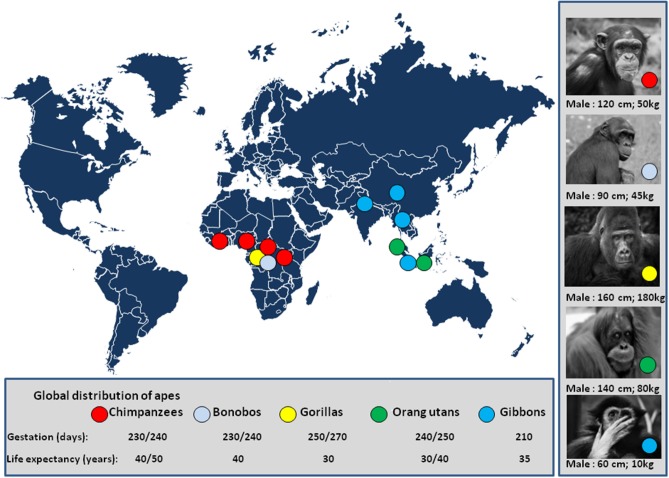Figure 5.
Global distribution of apes. The number of chimpanzees was estimated one million 50 years ago. A decade ago, the estimated number of chimpanzees was 250,000 individuals in a wild area extending from Western Africa (Gabon) to Central Africa (81), and it is likely about 200,000 individuals to date. The population of bonobos is estimated to be 20,000 individual living in DRC (82); The mountain gorilla population comprises about 1,000 individuals in two populations; the first lives in the Uganda's Bwindi national park (Napa) (83) and the second in the Virunga mountains a wildlife area shared by the Uganda's Mgahinga Napa, the Rwanda's volcanoes Napa, and the Virunga Napa of DRC (84). A population of about 4,000 Grauer's gorillas (eastern lowland gorillas) is found in DRC, mostly in the Kahuzi-Biega and Maiko Napa (85). About 250 Cross River gorilla live in Cameroun and Nigeria (86). The population of orangutans in Borneo is about 100,000 individuals, 6% live in captivity (87), and 15,000 individuals live in Sumatra (88). The global demand for natural resources eliminated more than 100,000 Bornean orangutans in the past decades with projection below 50,000 individuals in 2025 (89). The population of gibbon is about 47,000 in Thailand; 4,500 agile gibbons in the Bukit Barisan Selatan NP of Indonesia; 5,000 sylver gibbons in Java; and, 2,000 individuals in China (90). There are other places where apes have been acclimated in Napa from the US and Europe (e.g., among 9 zoos/parks presenting bonobos in Europe, “Vallée des singes”/monkey valley park, France, maintains 20 captive/semi-free bonobos originating from DRC or born in captivity). Pictures of apes are from the sponsored shutterstock free website https://pixabay.com/fr/. Illegal trade with some zoos is also a threat for apes. The international trafficking of apes was well-documented in a report from UNEP and UNESCO (91).

